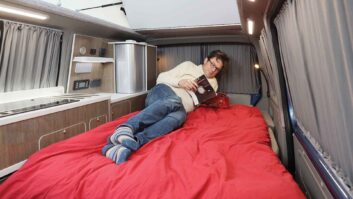It was nearly five months after we’d dropped Wilma off at the workshop that my phone rang with the news we’d been waiting for.
“Good news, mate,” said Leigh Hicks, owner of Combe Valley Campers. “She’s passed her MoT and is ready for you to pick up.”
We were finally going to be reunited with our ’van.
We headed down to Combe Valley’s HQ near Bexhill-on-Sea and there, sat outside the workshop, was our T25 VW camper van.
But she didn’t look quite as we remembered.
What a revelation
Last time we had seen her, she was being recovered onto the back of a low-loader, due to engine fire damage.
On inspection, Leigh had gone through the whole ’van, putting together a plan for fixing the fire damage, but also to pre-empt any other issues lurking underneath – and to fix them, too.
Leigh walked us around all the work he’d done.
The most obvious things were the fact that she had been extensively cleaned and mopped with a cutting compound. She is never going to be a showroom ’van and she still sported her various dents and scrapes, but she certainly looked a lot smarter.
Another little improvement was that the horrible plastic wheel trims had been ditched in favour of the proper painted ones and chrome wheel finishers.
The newly trimmed seats, the immaculate engine bay, and the numerous other little tweaks and touches meant she looked better than ever.
But the proof of this pudding was going to be in the driving.
Back on the road!
After a quick cuppa with Leigh, we jumped into our VW camper van and started the 75-mile journey home, opting to avoid the main roads, in favour of a meander along the south coast and an A-road route back to west London.
In the first 10 yards, it was apparent that she was transformed.
The most obvious difference was the steering which now had power assistance. Piloting Wilma though the yard and out to the main road didn’t require the grimacing and gurning needed before, as drivers wrestled with the heavy, vague steering.
It wasn’t just the power steering, either. Two badly mangled steering joints were replaced as well, removing much of the slop from the tiller.
A new clutch cable meant driving was more comfortable as the pedal sat at a better height. The gear linkage had also been adjusted and serviced, which made selecting gears less of a lottery.
In addition, the brakes had considerably more bite, thanks to new pads and calipers at the front, and correctly adjusted drums at the back.
Stronger than ever
Switching the 1600CT four-cylinder engine to twin Weber carburettors from a single Pierburg improved the throttle response and made the camper van feel more lively.
Although that is relative. Wilma is not fast, but she did feel strong for the first time in our ownership.
Leigh did warn us, though, that it was worth booking in a visit to a rolling road to set up the sensitive fuelling system precisely. She still has a little flat spot when accelerating which, he was sure, could be sorted by a rolling road visit.
The journey was completed with minimal fuss and we got back home without any problems.
We even filled up with petrol and none leaked out onto the floor – a first since we’ve had her.
Time to put our VW camper van to the test
In terms of the cost, let’s just say it was a substantial, four-figure sum, which comfortably eclipsed what we paid for the ’van in the first place.
By any conventional measure, a total spend of more than £10,000, including purchase, on a vehicle which is worth between £6-£7k does not represent very good value.
It’s hard to argue. It ably demonstrates that owning and running an older camper van, whether a VW or something equally old, will rarely be the budget option that you might think.
Clearly, Wilma had not been looked after very well for a long time prior to us purchasing her. But she is also 37 years old, meaning plenty of bits and bobs were just plain worn out.
We essentially did 10 years of maintenance in one go, along with a few upgrades. Thought of in those terms, at least the maths seems a little more manageable. But it’s still a lot of money.
Now the money is spent, however, the only thing left to do is to enjoy our ’van for what she is designed for – going on holiday!
And that’s exactly what we’ve planned, to find out what Leigh’s time and our money have really done to improve the usability and reliability of our T25 VW camper van.
In the first 10 yards, it was apparent that she was transformed









